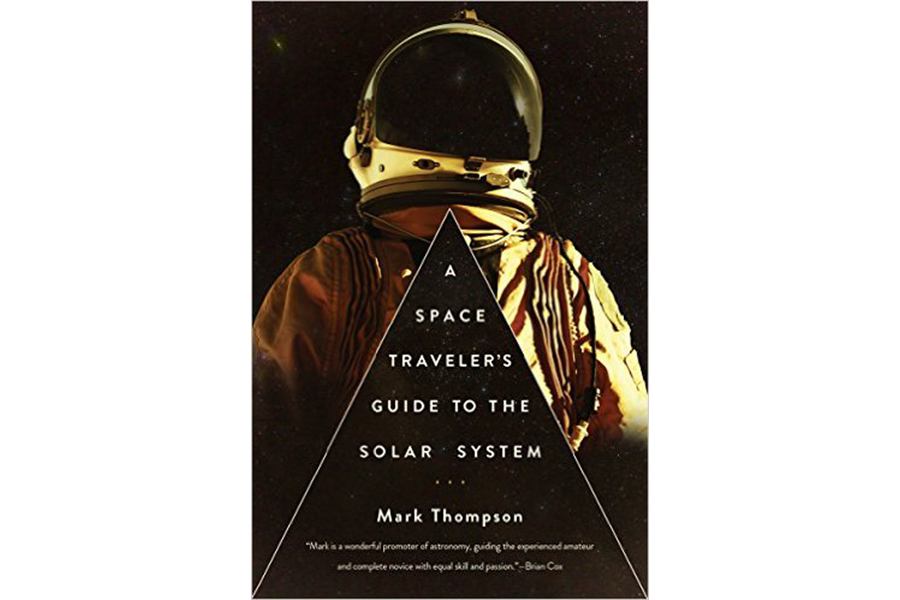'A Space Traveler’s Guide to the Solar System' leads readers into space
Armchair travelers bored with reading about French cuisine and Mediterranean cruises can book a fantasy flight on board the Kaldi. First stop: the Moon. And after that, places like Venus, Mercury, and even Callisto, one of the moons of Jupiter.
It’s an audacious journey, but one with experiential rewards far beyond lunching on quiche in Paris. The Kaldi, for example, will do a perilous loop around the Sun, our beyond-brilliant orb that could easily bake the spaceship to ashes. From there, it’s on to Mars.
“Mars is a great place for a short excursion to the surface,” we learn. “It feels like you’re in the middle of a vast red desert.... The surface is not too dissimilar to the Moon’s with a powdery coating almost the consistency of talcum powder....”
Meanwhile, there’s no need to stew over how much to tip the waiter: on board the Kaldi is “a fully functioning computerized hydroponics nursery ... [providing] a range of fruit, vegetables and herbs....”
The Kaldi and the journey it offers are the creation of Mark Thompson, a space aficionado and writer who brings his enthusiasm for astronomy to various programs on British television.
His book title – A Space Traveler’s Guide to the Solar System – must be a nod to Douglas Adams’s similarly titled series of galactic adventures. But rather than use wacky humor to enable the journey, Mr. Thompson employs current science, along with today’s rapidly expanding knowledge of our solar system, to enable us to visit places no one has gone before.
Thompson comments: “Clearly interplanetary space travel is not for the faint-hearted, but to be able to see the beautiful and enigmatic Saturn, the jewel of the Solar System, at first hand is going to make it all worthwhile.”
Of course there’s an extraordinary amount to learn before traveling from the Sun through to interstellar space is possible. (One problem: this excursion would require the traveler to take more than 42 years off from work.) Where current science doesn’t offer even speculative solutions to the challenges of this journey, Thompson employs what he calls a Reality Suspension Unit.
The RSU allows us, for example, to visit the inhospitable surface of Venus, where “crushing pressures” and “extreme heat” would otherwise have prevented us from enjoying its dark surface “sculpted by volcanic activity.”
Meanwhile, there are places even the RSU can’t enable us to hop off to experience, like the gas giants Jupiter, Saturn, Uranus, and Neptune.
Even flying the Kaldi itself into the gas clouds of Jupiter is impossible because atmospheric pressure and heat would “mean an end to the mission.” However you can fly close enough to view “the stunning detail in the upper atmosphere of the planet.”
There are similarities between "A Space Traveler’s Guide" and a really long road trip during which each stop offers unique new sites to see – and unique challenges. But along this journey, you learn a lot about science, and about the nature of the universe.
Here’s a tidbit about Jupiter, “dubbed the ‘cosmic hoover.’” “Its sheer presence attracts many asteroids and comets towards it, keeping us a little safer. Estimates suggest that Jupiter experiences around 5,000 more impacts per year than Earth.”
The science Thompson shares may require a few orbits to absorb for those who aren’t rocket scientists. But I recommend giving even the highly technical material a go, knowing that before long Thompson will return to the business of getting us on to our next stellar stop.
There’s also a lot of history here; Thompson nicely shares everything from the telescopic discoveries of great bearded astronomers like Galileo to the adventures and misadventures of recent unmanned space missions.
It’s a very worthwhile journey through our colorful and quirky solar system. And Thompson is a thorough and reliable guide, whose deep knowledge makes you confident in the accuracy of his descriptions.
My quibble is that there aren’t enough scenic descriptions. There are missed opportunities when Thompson could have loosened his space helmet and used his understanding to better help us imagine these places. If I’ve traveled 4.3 billion kilometers to fly by Neptune, I want to return with some really good snapshots!
Nonetheless, "Space Traveler’s Guide" brilliantly leads readers into space. It’s an astronomical travelogue that blasts us out of our little world, and shows us how, in a few decades, we could be cruising our solar system. Cheese tasting on the moon, anyone?







